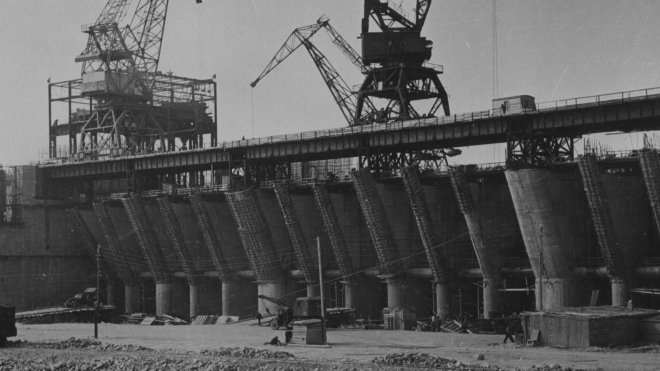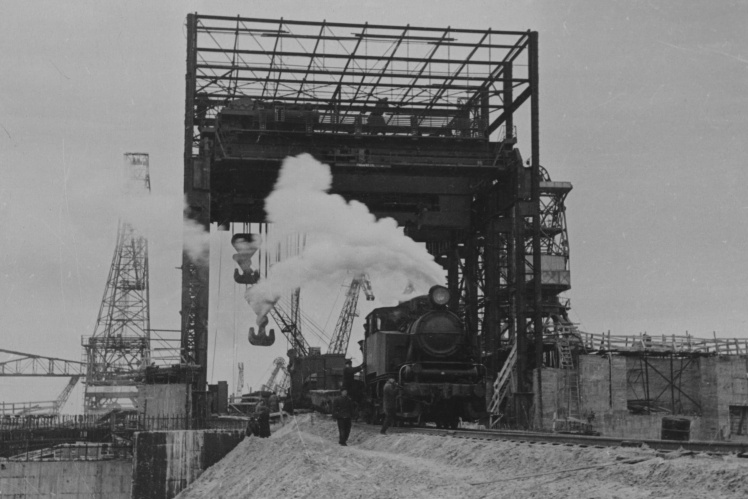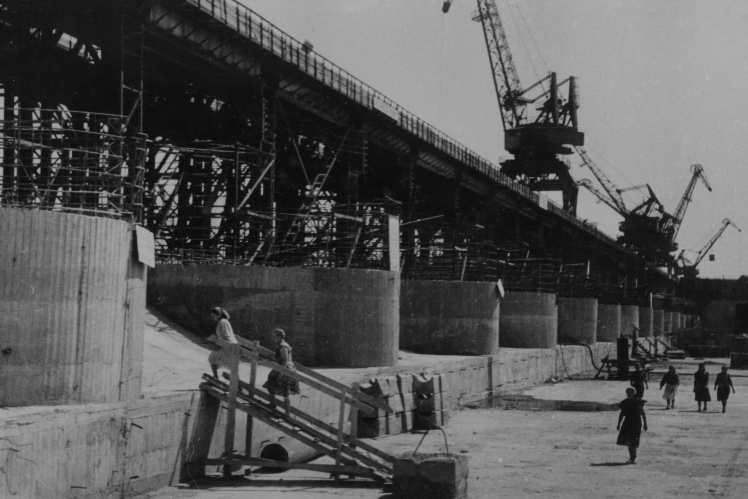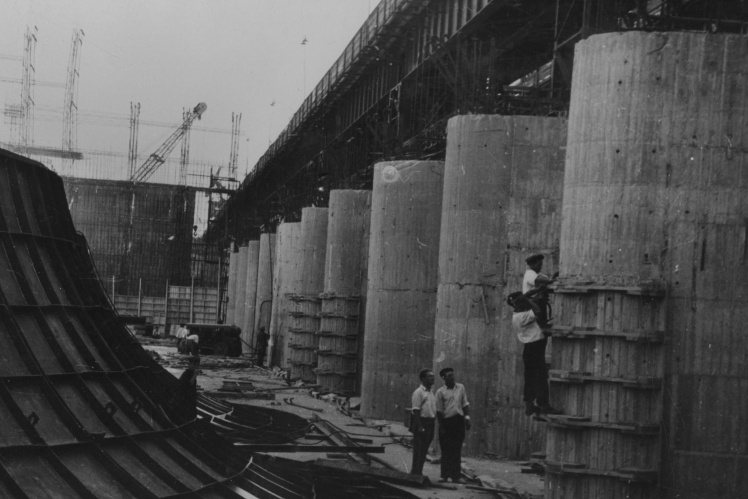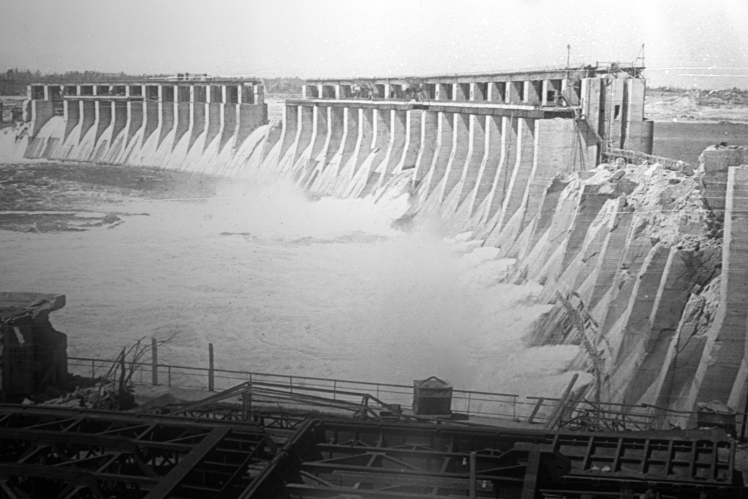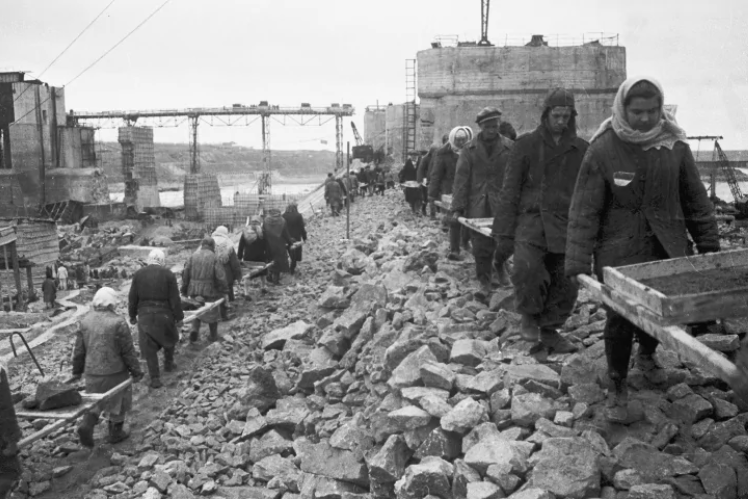Post-war devastation reigned in the USSR after the Second World War. A large-scale drought, lack of equipment and workers led to a mass famine in 1946-1947. By that time, the United States had already stopped supplying food to the Soviet Union as part of Lend-Lease program. Despite this, Stalin sent almost two million tons of grain to the socialist camp countries in Europe. This is how the famine turned into another famine, from which about a million people died, the vast majority of them — in Ukraine.
Soviet propaganda put all the blame for the tragedy on bad weather. And the party leadership decided to tame nature — of course, under the leadership of Comrade Stalin. At the end of October 1948, on the initiative of the Soviet dictator, a resolution was adopted, which the newspapers dubbed the “Great (or Stalinʼs) plan for the transformation of nature.” The project was designed for 1949-1965. During this period, it was necessary to plant more than five thousand kilometers of forest strips, which were supposed to protect the fields from droughts. Drain large areas of land so that they can be farmed. And build canals and irrigation systems. All this was supposed to change the climate on an area of 120 million hectares.
Soviet propaganda poster dedicated to the “Plan for the Transformation of Nature”, 1949. “We will win over the draught too!” is written next to Stalin.
Wikimedia / «Бабель»
A separate point of this plan was the construction of powerful hydroelectric power plants on the largest rivers of the European part of the USSR — Volga, Don, Dnipro. Soviet propaganda called these projects “great constructions of communism.” The last completed construction of these was the Kakhovka HPP.
At the end of September 1950, the construction began — of the actual hydroelectric power plant, reservoir and canal system. At the same time, a new city was under construction nearby, which was later named Nova Kakhovka. More than 10,000 workers from all over the Soviet Union were involved in the construction. The HPP was built ahead of schedule, in five years instead of six. Already on October 18, 1955, the stationʼs first turbine was launched.
Concreting of the foundation part of the Kakhovka HPP dam, 1954. Locomotive under the construction of the Kakhovka HPP, 1954. A floating bridge for blocking the Dnipro River during the construction of Kakhovka HPP, 1955.
uhe.gov.ua / «Бабель»
Articles and films were made about the progress of the construction and the enthusiasm of the workers from the submission of Soviet propaganda. Numerous delegations of high-ranking officials came to the site and made speeches that “communism is almost here.” In reality, no conditions were created for the workers. They were not provided with housing, their salaries were delayed, and there were interruptions in the food supply. In letters to their relatives, the workers wrote how they stood in queues for bread, washed themselves in the river, and nearly lost their minds from hunger, while being forced to work from 9 am to midnight.
Construction of the spillway dam of Kakhovka HPP, 1954. Cladding works at Kakhovka HPP, 1954. Installation of the generator rotor of the first turbine of the Kakhovka HPP, 1955.
uhe.gov.ua / «Бабель»
The Kakhovka reservoir was conceived as the largest in the world in terms of area and volume of water. And the North Crimean canal, which was planned to be dug from it, was not only supposed to supply water to the Crimea. The authorities wanted to make it navigable, connect it with the Sea of Azov and transport up to 10 million tons of cargo per year. A large network of irrigation canals was supposed to provide water not only to the Crimea, but also to the entire south of Ukraine. Local agriculture had to reorient itself to the cultivation of cotton and rice.
To do this, the government decided to flood tens of thousands of hectares of the most fertile land, floodplains, forests and lakes between Zaporizhzhia and Kakhovka. The historical area of Velykyi Luh, where several Cossack headquarters were located, also went underwater. The construction also flooded about 90 villages on both banks of the Dnipro, where at least 37,000 people lived.
Stills from the 1958 film "Poem about the Sea" about the construction of the Kakhovka HPP, directed by famous Ukrainian film director Oleksandr Dovzhenko.
YouTube / «Бабель»
The 230-kilometer-long Kakhovka reservoir was filled until 1958. And only after that it turned out that the Soviet experts were wrong in their calculations. Evaporation of water turned out to be much greater than planned. In addition, as part of “Stalinʼs transformation of nature”, huge areas of Polissya began to be drained. Due to this, significantly less water began to enter the Dnipro River. It was not possible to fill the Kakhovka reservoir to the appropriate technical parameters. So the new artificial sea turned out to be not enough for the network of irrigation channels.
Kakhovka reservoir, August 1955.
Getty Images / «Babel'»
The reservoir of Dnipro HPP didnʼt solve this problem either. Therefore, it was necessary to complete the construction of four more reservoirs upstream of the Dnipro. Construction continued until the mid-1970s, when the Dnipro cascade of dams was formed. During their construction, military and strategic calculations were also carried out. The Soviet Union already had the experience of destroying the Dnipro HPP during the Second World War. Now the modeling of what will happen if the entire cascade of dams on the Dnipro is destroyed was considered. Calculations showed that in this case, a huge swamp would form, impassable for infantry and equipment for at least a month.
The destroyed dam of Dnipro HPP, 1944. Collective farm workers rebuild the destroyed Dnipro HPP, April 1945.
The construction of the Kakhovka HPP and reservoir also had a foreign policy task. In 1942, the most powerful Grand Coulee hydroelectric plant on the Columbia River in the Rocky Mountains was launched in the United States at that time. It was important for the leadership of the USSR to demonstrate to the whole world that they can do no worse. And Kakhovka HPP coped brilliantly with this task.
In the early 1950s, the Egyptian government was going to build a new dam on the Nile. And at that time, the Soviet Union and the countries of the West were competing for influence in Africa. Initially, Egypt agreed to the British-American dam project. However, after the completion of the Kakhovka HPP, Soviet officials brought Egyptian specialists here. Like, look: the Americans can build dams only in the mountains, with small reservoirs, and they spend almost ten years on it. And we are building in the river plain, with a huge reservoir-sea, in the shortest possible time, and we will also take over a third of the construction costs.
A delegation of Egyptian and Soviet high-ranking officials at the construction of the Aswan Dam, 1960s.
Getty Images / «Babel'»
Thus, in 1970, the Upper Aswan Dam, designed by Soviet engineers, appeared in Egypt. As in the case of Ukraine, the construction of a huge reservoir endangered many historical monuments. UNESCO organized a special rescue operation to save them.
After Stalinʼs death in 1953, the "plan for the transformation of nature" began to be gradually curtailed. Some projects were left unfinished. Stalinʼs successor, Nikita Khrushchev, started his own grandiose experiment in agriculture, which turned into a large-scale food crisis for the Soviet Union.
First Secretary of the Central Committee of the Communist Party of the Soviet Union, Nikita Khrushchev (left) with the collective farm and party leadership of the village of Velyki Luchky, Mukachevo District, Zakarpattia region of Communist Ukraine, during the “corn campaign”, 1959.
Translated from Ukrainian by Anton Semyzhenko.
We donʼt undermine the trust of our readers with fakes. So support us: 🔸 in hryvnia 🔸 in cryptocurrency 🔸 Patreon 🔸 PayPal: [email protected]
